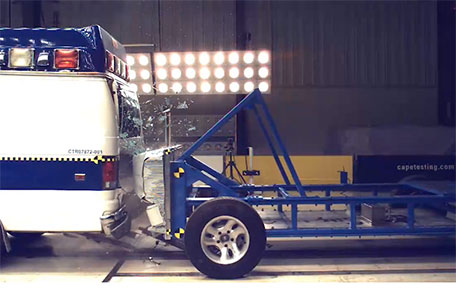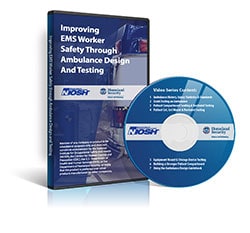EMERGENCY MEDICAL SERVICES WORKERS
Ambulance Test Methods

Ambulance crash test methods aim to improve the safety of the patient compartment to keep Emergency Medical Services (EMS) workers and their patients safe during transport. Learn about these crash test methods and how to design a safer ambulance for your service.
Ambulance crashes are a major safety concern for workers and patients alike. To address EMS worker safety, CDC’s National Institute for Occupational Safety and Health (NIOSH) partnered with Department of Homeland Security’s Science and Technology Directorate (DHS S&T) as well as other federal agencies and the ambulance manufacturing industry to conduct a series of ambulance crash tests and develop test methods for seating, the patient cot, equipment mounts, storage devices, and the ambulance body.
What is crash testing?
Crash testing is a controlled way of crashing a vehicle to measure its ability to withstand impact during an actual crash event. The same crash test methods that are used to test the safety of cars were used to test the safety of the ambulance.
Why is crash testing important?
Data collected from crash testing allows engineers to better understand how the structure reacts during crash events. These data also allow engineers to recreate the conditions in a lab setting to test and design safer structures and equipment. The ultimate goal of ambulance crash testing is to improve passenger safety for both EMS workers and their patients.
What are the ambulance crash test methods?
In total, 10 test methods were published by Society of Automotive Engineers (SAE) – the premier standards developing organization for the transportation and mobility industries – and covers everything from seat belts to the patient compartment structure. These test methods include:
- SAE J2917: Crash pulse from frontal impact
- SAE J2956: Crash pulse from side impact
- SAE J3026: EMS worker seating and restraints integrity
- SAE J3027: Patient cot, floor mount, and restraint system
- SAE J3043: Ambulance equipment mount devices and systems
- SAE J3044: Crash pulse from rear impact
- SAE J3057: Modular body (or box style) integrity
- SAE J3058: Storage compartment integrity
- SAE J3059: Measurement of EMS worker head movement during a crash event
- SAE J3102: Floor integrity test to support the patient cot
Who can use these test methods?
- Ambulance builders and major component suppliers can use the criteria to design and test their vehicles, seats and cots, among other devices to improve occupant safety during a crash event.
- Those responsible for designing or purchasing ambulances for a service should familiarize themselves with these test methods as well as DHS S&T’s Ambulance Patient Compartment Human Factors Design Guidebook, pdf icon[2.15 MB]external icon1 to determine how to design a compartment that meets the needs of a particular service while improving worker safety and patient care.

NIOSH & DHS S&T produced a 7-part video series on test methods and considerations when purchasing or building an ambulance.
- Department of Homeland Security, Science and Technology Directorate [2015]. Ambulance Patient Compartment Human Factors Design Guidebook. pdf icon[2.15 MB]external icon
